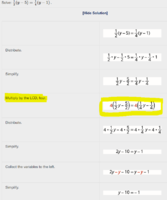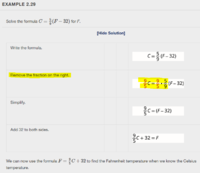How do i know when to use: Removing Fraction vs LCD
- Thread starter bobisaka
- Start date
Powerful Wizard IRL
New member
- Joined
- Mar 3, 2021
- Messages
- 3
The mistake you made was in your first step when you expanded the expression 95(F−32). When you expand this expression, each term inside the parentheses must be multiplied by the factor outside the parentheses. So,
\[
C = \frac{5}{9} (F - 32) = \frac{5}{9}(F) - \frac{5}{9}(32) = \frac{5}{9} F - \frac{160}{9}
\]
If you continue from this point, you should arrive at the correct answer.
\[
C = \frac{5}{9} (F - 32) = \frac{5}{9}(F) - \frac{5}{9}(32) = \frac{5}{9} F - \frac{160}{9}
\]
If you continue from this point, you should arrive at the correct answer.
Dr.Peterson
Elite Member
- Joined
- Nov 12, 2017
- Messages
- 16,822
5/9 * 32 isn't 160, is it?C = 5/9 F - 160 (it should not be 160 either?)
You can always do it either way -- as long as you do it right! And I've seen students make mistakes both ways.How do i know when to remove a fraction via multiplying fraction with inverse of itself vs multiplying both sides using LCD.
In this case, if I wanted to clear fractions first, I'd multiply both sides by 9:
C = 5/9 (F - 32)
9*C = 9*5/9 (F - 32)
9C = 5(F - 32)
9C = 5F - 160
9C + 160 = 5F
(9C + 160)/5 = F
And if you want, you can distribute the division:
F = 9C/5 + 32
But what they do is a little more efficient; since F appears only in one place, inside the parentheses, it makes sense to just "unwrap" it one layer at a time, first undoing the multiplication by 5/9, then undoing the subtraction of 32.
I do not know what lowest common divisor has to do with anything in this problem.
You can do the problem the way you are thinking
[MATH]C = \dfrac{5}{9} * (F -32) = \dfrac{5}{9} * F - \dfrac{5}{9} * 32 = \dfrac{5}{9} * F - \dfrac{160}{9} \implies[/MATH]
[MATH]\dfrac{5}{9} * F = C +\dfrac{160}{9} \implies \dfrac{9}{5} * \dfrac{5}{9} * F = \dfrac{9}{5} * C + \dfrac{9}{5} * \dfrac{160}{9} \implies[/MATH]
[MATH]F = \dfrac{9}{5} * C + 32.[/MATH]
That is a perfectly correct method mathematically. The error that you made was that you multiplied - 32 by 5 rather than 5/9.
However, that method is likely to lead to careless errors. Start by clearing fractions and multiply by 9..
[MATH]C = \dfrac{5}{9} * (F -32) \implies 9C = 5(F - 32) = 5F - 160 \implies[/MATH]
[MATH]5F = 9C + 160 \implies F = \dfrac{9}{5} * C + \dfrac{160}{5} = \dfrac{9}{5} * C + 32.[/MATH]
Both ways are mathematically valid. The second way is easier and less error prone.
You can do the problem the way you are thinking
[MATH]C = \dfrac{5}{9} * (F -32) = \dfrac{5}{9} * F - \dfrac{5}{9} * 32 = \dfrac{5}{9} * F - \dfrac{160}{9} \implies[/MATH]
[MATH]\dfrac{5}{9} * F = C +\dfrac{160}{9} \implies \dfrac{9}{5} * \dfrac{5}{9} * F = \dfrac{9}{5} * C + \dfrac{9}{5} * \dfrac{160}{9} \implies[/MATH]
[MATH]F = \dfrac{9}{5} * C + 32.[/MATH]
That is a perfectly correct method mathematically. The error that you made was that you multiplied - 32 by 5 rather than 5/9.
However, that method is likely to lead to careless errors. Start by clearing fractions and multiply by 9..
[MATH]C = \dfrac{5}{9} * (F -32) \implies 9C = 5(F - 32) = 5F - 160 \implies[/MATH]
[MATH]5F = 9C + 160 \implies F = \dfrac{9}{5} * C + \dfrac{160}{5} = \dfrac{9}{5} * C + 32.[/MATH]
Both ways are mathematically valid. The second way is easier and less error prone.
I do not know what lowest common divisor has to do with anything in this problem.
In terms of the LCD, here is an example in the previous chapter of when LCD is used to multiply the fractions . How does the strategy differ to the current question I am on.
I think this is my problem in terms of understanding when to use the correct solution/strategies for different equations and/or perhaps what the question is asking itself??
The strategy that was in my thinking was at least the LCD/Multiplication part of "Solve Equations with Fraction or Decimal Coefficients" and applying that to "Solve a for a Specific Variable"
I am already getting confused. I would like to understand more clearly what I am missing in my current understanding?
Is my approach wrong?

I do apologize. Let me clarify; I was not saying that anything you have been taught is wrong. There frequently are different but equally valid ways to solve a problem.
What I am saying is that ”clearing fractions,” that is “eliminating all fractions from the equation,“ is USUALLY the least error prone method when it can be applied without great difficulty.
There are, moreover, two methods of clearing fractions. One is to multiply both sides of the equation by the least common denominator of all the denominators in the equation. The other is to multiply both sides of the equation by the product of all the denominators. Both methods are equally valid.
Common denominator method.
[MATH]\dfrac{1}{2} * (y - 5) = \dfrac{1}{4} * (y - 1).[/MATH]
It is obvious that 4 is the least common multiple of the denominators.
[MATH]4 * \dfrac{1}{2} * (y - 5) = 4 * \dfrac{1}{4} * (y - 1) \implies 2(y - 5) = (y - 1) \implies[/MATH]
[MATH]2y - 10 = y - 1 \implies 2y - y = 10 - 1 \implies y = 9.[/MATH]
However, finding a least common multiple of the denominators is often a lot of work, and that work is never necessary. You can always clear fractions by multiplying by the product of the denominators. In this case 2 * 4 = 8.
[MATH]\dfrac{1}{2} * (y - 5) = \dfrac{1}{4} * (y - 1) \implies 8 * \dfrac{1}{2} * (y - 5)= 8 * \dfrac{1}{4} * (y - 1) \implies [/MATH]
[MATH]4(y - 5) = 2(y - 1) \implies 4y - 20 = 2y - 2 \implies 4y - 2y = 20 - 2 \implies 2y = 18 \implies y = 9.[/MATH]
You NEVER have to use a least common multiple of the denominators to clear fractions although it is sometimes the fastest way to proceed.
What I am saying is that ”clearing fractions,” that is “eliminating all fractions from the equation,“ is USUALLY the least error prone method when it can be applied without great difficulty.
There are, moreover, two methods of clearing fractions. One is to multiply both sides of the equation by the least common denominator of all the denominators in the equation. The other is to multiply both sides of the equation by the product of all the denominators. Both methods are equally valid.
Common denominator method.
[MATH]\dfrac{1}{2} * (y - 5) = \dfrac{1}{4} * (y - 1).[/MATH]
It is obvious that 4 is the least common multiple of the denominators.
[MATH]4 * \dfrac{1}{2} * (y - 5) = 4 * \dfrac{1}{4} * (y - 1) \implies 2(y - 5) = (y - 1) \implies[/MATH]
[MATH]2y - 10 = y - 1 \implies 2y - y = 10 - 1 \implies y = 9.[/MATH]
However, finding a least common multiple of the denominators is often a lot of work, and that work is never necessary. You can always clear fractions by multiplying by the product of the denominators. In this case 2 * 4 = 8.
[MATH]\dfrac{1}{2} * (y - 5) = \dfrac{1}{4} * (y - 1) \implies 8 * \dfrac{1}{2} * (y - 5)= 8 * \dfrac{1}{4} * (y - 1) \implies [/MATH]
[MATH]4(y - 5) = 2(y - 1) \implies 4y - 20 = 2y - 2 \implies 4y - 2y = 20 - 2 \implies 2y = 18 \implies y = 9.[/MATH]
You NEVER have to use a least common multiple of the denominators to clear fractions although it is sometimes the fastest way to proceed.
Okay great, that clarifies things.
In terms of doing it the slow way, I try to follow each step in the textbook hoping that it would help me understand it more clearly.
Do you think it is better for me to continue doing it this way?
or would you say it is better to do the quicker or more efficient way?
In terms of doing it the slow way, I try to follow each step in the textbook hoping that it would help me understand it more clearly.
Do you think it is better for me to continue doing it this way?
or would you say it is better to do the quicker or more efficient way?
Whatever way is most intuitive to you is the best way for you.Okay great, that clarifies things.
In terms of doing it the slow way, I try to follow each step in the textbook hoping that it would help me understand it more clearly.
Do you think it is better for me to continue doing it this way?
or would you say it is better to do the quicker or more efficient way?
I must admit that the idea of multiplying by the product of the denominators as a way of eliminating all fractions is intuitive to me, but multiplying by the least common denominator is mathematically equivalent. Whichever way makes you most comfortable is what you should do. The point is to get correct results; you are less likely to make errors if you are using a method that makes sense to you.
Whatever way is most intuitive to you is the best way for you.
I must admit that the idea of multiplying by the product of the denominators as a way of eliminating all fractions is intuitive to me, but multiplying by the least common denominator is mathematically equivalent. Whichever way makes you most comfortable is what you should do. The point is to get correct results; you are less likely to make errors if you are using a method that makes sense to you.
Thank you!?

